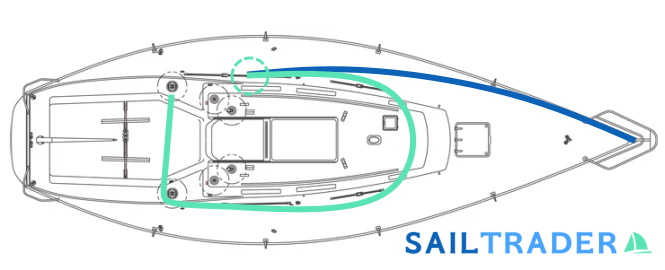Table of Contents
Welcome to the world of sailing! One of the most important components of your sailing experience is the genoa sheet, no matter how much of a veteran you are. As you may have deducted, this critical piece of equipment helps control the trim and shape of the genoa sail, allowing you to steer your boat in the right direction and get the most out of your sailing experience.
In this comprehensive guide, we’ll take a closer look at what genoa sheets are, how long they should be, the best rope types to use, and how to attach them to your boat. With the right information, you’ll be well on your way to choosing the best genoa sheet for your needs and taking your sailing to the next level. So, set sails and join us on our odyssey!
What are Genoa Sheets?
Genoa sheets are an essential component of sailing. They’re the ropes that control the shape and trim of the genoa sail on your boat, helping balance the boats helm through the water. Sailors can control the angle of the sail in relation to the wind by adjusting the genoa sheets, which ultimately affects the speed and performance of the boat.
If you’re new to sailing – or simply like visual references – think of the genoa sail as a large triangular sail that sits at the front of the boat, helping to propel it forward. The genoa sheet runs from the clew of the sail (the lower corner) to the winch or jammers on the boat, allowing sailors to control the shape and trim of the sail.
How Long Should Genoa Sheets Be?
So, how exactly do you determine the perfect length for your genoa sheets? It’s simple, measure from the position of the genoa clew (when trimmed to an upwind position), follow on the outside of the side-stays, go around the front of the mast (or follow the pathway of the clew through a tack) and through the genoa car on the opposite side of the boat. Continue around the winch, then the length across the cockpit to the opposite winch. This will give you enough line to pre-wrap the genoa sheets on the windward winch prior to tacking but not too much where the sheets are getting tangled. Start sailing with them at that length and then trim them back as necessary.
With everything in sailing, there is some trial and error required to find the perfect balance, so don’t rush your decision. And, if you’re unsure of the ideal length for your genoa sheets, try to reach out to a sailing expert.
What Kind of Rope is Recommended for Genoa Sheets?
When you’re choosing the right rope for your genoa sheets, you need to consider both strength and durability. The last thing you want is to be in the middle of a sail and have your sheet break, leaving you in a dangerous predicament. There are a few options to consider when selecting your rope, each with its own benefits and drawbacks.
Dacron or polyester are popular choices for genoa sheets because they are resistant to UV rays and abrasion. This means that it’s less likely to deteriorate or break down over time, making it a reliable option for long-term use. Dyneema®, a high-performance synthetic fiber, is also a great option for its light weight and strength. This makes it easier to handle, but it’s also more expensive than other rope options. If you’re looking for a lightweight, high-performance rope, then Dyneema® is definitely worth considering.
When it comes to strength, you want a rope that has a low stretch. This will give you precise control over your sail’s trim and shape, so you can make accurate, real-time adjustments and get the most out of your sailing experience. But no matter which rope you choose, you need to make sure it’s of high quality and keep it well-maintained. This means storing it properly, inspecting it regularly for signs of wear and tear, and replacing it when necessary.
Genoa Sheet Recommendations
How to Attach Genoa Sheets?
Attaching your genoa sheets properly is essential to maximizing their performance. There are two main methods for attaching genoa sheets to your sail: splicing and tying.
Splicing involves weaving the end of the rope through itself to create a loop, which is then secured with a knot. This method is considered more secure and is often used for racing boats. The loop is then attached to the clew of the sail using a shackle or a snap hook, depending on the size of your boat.
Tying, on the other hand, involves tying a bowline knot around the clew of the sail and securing it with a back splice. This method is easier for beginner sailors and is often used for recreational boats. Make sure to use high-quality knots, such as the figure eight knot, and secure them tightly to prevent any slippage.
It’s also important to consider the type of winch or jammers you have on your boat. Some winches have a special cleat or jammer to secure the genoa sheet, while others have a simple block and tackle system. Make sure you’re familiar with your boat’s system and know how to secure the sheet properly.
Lastly, it’s a good idea to invest in a good quality winch handle, as this will make it easier to adjust the sheet while sailing. A handle with a comfortable grip and a smooth ratchet mechanism will make your sailing experience much more enjoyable.
Last Thoughts
It’s essential to consider factors such as length, rope type, thickness, and attachment method when selecting a genoa sheet. With the right information, you can make an informed decision and ensure you have the best sailing experience possible.
No matter your experience level is, it’s always worth taking the time to understand the various components of your boat and how they work together. So get ready to hit the open water and enjoy a smooth sail with the right genoa sheet by your side.
Happy sailing!








